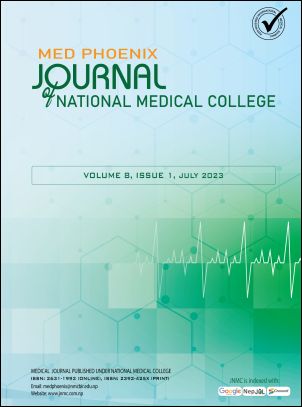Evaluation of Ring Enhancing Lesions in the Patient Undergoing Brain CT Scan
DOI:
https://doi.org/10.3126/medphoenix.v8i1.54401Keywords:
Computed tomography, Neurocysticercosis, Ring enhancing lesionsAbstract
Introduction: Ring enhancing lesions in CT of the brain can be caused by different pathological conditions. The common lesions being some granulomas, primary brain tumors, abscess etc. CT remains essential for the investigation of ring enhancing lesions of brain.
Materials and methods: A cross-sectional study was performed on a total of 60 patients undergoing brain CT scans and found to have ring enhancing lesion(s) on contrast administration.
Results: The result of the study revealed that ring enhancing lesions was more common in man than women (34 out of 60 patients; 56.7%) The overall male to female ratio was 1.3:1. The age of the patients ranged from 7 to 77 years with peak incidence of lesion was found in >40 years of age comprising 28 patients (46.7%) followed by 21 to 30 age groups constituting 12 patients (20%). Single ring enhancing lesions were most common lesions comprising about 49 cases (81.67%). Neurocysticercosis (NCC) was the most common cause of ring enhancing lesions of brain comprising about 38 patients (63.3%) followed by glioblastoma multiforme (GBM) comprising about 9 patients (15%).
Conclusion: CT plays an important role in the diagnosis of ring enhancing lesion and their causes. Neurocysticercosis (NCC) was the most common cause of ring enhancing lesions followed by glioblastoma multiforme (GBM).
Downloads
Downloads
Published
How to Cite
Issue
Section
License
Copyright (c) 2023 Med Phoenix

This work is licensed under a Creative Commons Attribution 4.0 International License.
Copyright on any research article is transferred in full to MED PHOENIX upon publication. The copyright transfer includes the right to reproduce and distribute the article in any form of reproduction (printing, electronic media or any other form).
© MEDPHOENIX
![]()
Articles in the MED PHOENIX are Open Access articles published under the Creative Commons CC BY License (https://creativecommons.org/licenses/by/4.0/). This license permits use, distribution and reproduction in any medium, provided the original work is properly cited.




